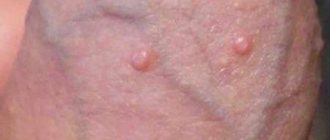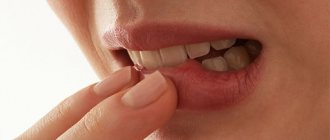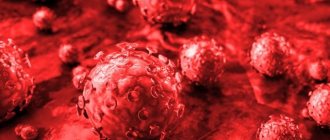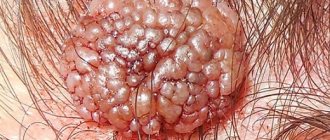Filiform papillomas (acrochords) are benign warty-type neoplasms that appear on the skin. They have an elongated shape and resemble a broken thread, which is why they got their name.
Such growths do not pose an immediate threat to human health, but can cause him some discomfort.
Reasons for appearance
Many people are carriers of one or another type of neoplasm, since almost everyone is infected with some type of HPV. This is due to the various routes of infection characteristic of viral elements. These include:
- Contact. Infection occurs through direct contact with an HPV carrier. The virus enters the body through minor skin lesions, during handshakes, and when sharing utensils with an infected person.
- Infection due to physical contact with a surface containing the virus.
- Self-infection during the process of internal migration of the virus from damaged areas of the skin to healthy ones.
It should be noted that not in all cases the virus that is in the human body multiplies, provoking the formation of filamentous warts. A healthy immune system will become a natural obstacle to the activity of the virus. Often the patient himself provokes HPV to this. There are known reasons that activate the development of HPV:
- weak immunity,
- stressful situations,
- malfunction of the central nervous system,
- inflammatory process in the ovaries,
- gastrointestinal diseases,
- changes that are associated with age.
Pineapple juice
Pineapples are considered an exotic dessert, rich in vitamins and promoting healthy digestion. Who would have thought that the juice of amazing fruits can not only saturate the body with essential nutrients, but also eliminate filamentous warts, the treatment, removal and prevention of which are not always possible using traditional medicine? Its acidity, along with the presence of special enzymes in the liquid, makes it possible to effectively and quickly remove tumors.
Cut and peel a piece of pineapple, then squeeze out the fresh juice. Soak the wart in the juice for 5-10 minutes, then wipe it with a clean cloth. Repeat the procedure 2-3 times a day. It will take several days for the growth to completely disappear from the surface of the skin.
First signs
Filiform warts, papillomas or acrochords are minor neoplasms of viral origin.
Initial symptoms:
- Their appearance begins with a small yellow tubercle.
- Next, it transforms into an elongated growth on a stalk.
- Papillomas have an elastic consistency.
- The color is identical to the skin, but in certain situations it can be dark brown.
These growths prefer places with high humidity, for example, the armpits.
Diagnosis of acrochords
Diagnosis of a filiform wart, as a rule, does not present any difficulties. The diagnosis is based on an external visual examination by a dermatologist with the additional use (if necessary) of dermatoscopy, which is a hardware diagnostic technique. During the examination of the acrochord with a dermatoscope, angiopathy of the small vessels of the formation is revealed in the growths - a disturbed structure of the vascular walls, thrombosis with complete closure of the lumen or a decrease in its diameter.
Dermactoscopy allows, using multiple magnification of a digital or optical dermatoscope, to visually quickly and relatively easily evaluate and distinguish a filamentous wart from a birthmark, an ordinary flat papilloma, a pedunculated fibroma, as well as a benign skin neoplasm from a malignant one (basal cell carcinoma, melanoma). In cases where differential diagnosis is difficult, a histological examination of the acrochord is performed and confirmation of infection of the patient with the human papillomavirus using the polymerase chain reaction method.
Locations
When choosing a location, growths are quite selective: they appear where the skin is thinner, in the folds of the skin and in places of high humidity.
Often filamentous warts appear:
- in the facial area (affect the eyelids, frontal part, near the nose),
- in the groin area,
- cervical region,
- in the armpits,
- in women under the mammary glands.
In places with a thicker layer of skin, neoplasms are not observed.
Cryotherapy
Cryotherapy is a procedure in which fleshy skin lesions are exposed to liquid nitrogen. After treatment ends, small blisters may appear on the affected area.
Doctors recommend that their patients wear bandages on areas where filiform warts were previously located. The treatment is considered complete once the dead skin is removed.
If the growth has reached a large size, you will need to undergo several sessions of treatment with liquid nitrogen before the wart completely disappears. Depending on the exact number, size and location of the formations, doctors prescribe up to six cryotherapy sessions at intervals of 2-4 weeks.
Some people react very painfully to treating the skin surface with liquid nitrogen, so the freezing process is slowed down as much as possible and the effect on the growth is carried out gradually.
Cryotherapy may have side effects such as pain, tendon damage, superficial nerve damage, skin discoloration, scarring, or recurrence of viral warts.
Risk factors
Over time, the number of filamentous warts increases. Neoplasms are observed in almost half of the population after 50 years.
This is caused by the following factors:
- deterioration of the immune system,
- HIV infection,
- infectious lesion,
- metabolic failure,
- oncology,
- chronic diseases,
- unbalanced diet,
- constant trips to the solarium,
- old age,
- stressful situations,
- ultraviolet irradiation.
Symptoms
The only symptom of pedunculated papillomas is the appearance of a characteristic piece of flesh on the surface of the skin. There are usually no complications, but in some cases the formations cause discomfort and itching when caught by a razor, collar or bra shoulder.
It happens that they become inflamed, irritated, and even bleed slightly. Patients sometimes complain of physical pain and discomfort. Large papillomas can rupture under pressure.
It happens that the acrochordon spontaneously disappears without a painful reaction within 3-10 days, without requiring additional treatment. This occurs when it curls at the base of the stem and thus cuts off the flow of blood.
Thrombosed (or clotted), it can suddenly change color, become purple or black (from necrosis when skin tissue dies), and becomes irritated when there is an inadequate blood supply.
Treatment methods
In almost all cases, filamentous papillomas are not treated on their own (as, for example, juvenile or vulgar growths in childhood can disappear on their own). They need therapy. Moreover, when these neoplasms begin to be injured. Therapeutic measures involve the use of various methods.
Hardware removal
Elimination of filamentous warts is carried out using modern methods or through surgery. The most common methods:
- Laser removal. A modern and harmless way to eliminate various growths. The method is based on burning out the papilloma with a laser, after which a crust will remain, and after 3 days it will fall off. The operation requires local anesthesia; the laser action itself lasts no more than 1 minute. The downside will be the high price.
- Using Surgitron. Also a common technique is based on burning out warts using high-frequency radio wave current. The preparation process is identical to laser removal.
- Electrocoagulation. It is a harmless and proven method for eliminating filamentous papillomas. They are burned out using high-frequency current, after which anesthesia is performed. However, after such manipulation, a burn in the form of a crust will remain on the skin, under which the dermis heals for quite a long time - over 10 days. The method is distinguished by the affordable cost of the operation.
- Cryodestruction. It is the most effective way to eliminate acrochords, which is carried out even by a nurse without the presence of a doctor. The method is based on freezing the growth using liquid nitrogen. The tissues immediately die, then after 3-4 days the papilloma disappears. The disadvantage will be the impossibility of histological diagnosis.
- Surgical removal. It is used infrequently, since scars form after manipulation.
The choice of method for eliminating the growth depends on the individual characteristics of the patient’s body.
Traditional medicine recipes
You can quickly get rid of acrochords at home using various folk remedies:
- Use celandine 2 times a day. It is optimal to use juice from the plant stem for these purposes. It will take 14 days to completely eliminate small acrochords, but if there are no results, therapy can be continued.
- Grind a clove of garlic through a grater and add a drop of baby cream to the finished mixture. This product is used to properly lubricate the growth and secure it with a band-aid. The compress is left overnight. The procedure is repeated until the papilloma disappears.
- The use of rowan berries is effective. For 1 wart, 1 berry is enough: it is ground into porridge, then a compress is made in the same way as in the previous recipe. The advantage of this method is its harmlessness and the inability to injure healthy areas of the skin.
- Acetic and fruit acids. Every day you need to drip 1 drop of lemon or apple juice onto the papillomas twice.
- Take a small piece of iris leaf and knead until the juice appears. Apply to the wart and fix for 3-4 hours. It is done once a day.
It should be borne in mind that therapy with traditional medicine can cause inflammation and other complications, therefore independent treatment is unacceptable.
Treatment during pregnancy
Often pregnancy can be associated with unpleasant pathologies. Acrochords may appear during pregnancy. Thread-like papillomas up to 30 mm in length are observed. They are found in the eyelids, cervical region, under the arms, and on the genitals. During the fruiting period, this variety is found more often than others. Opening the growth is dangerous for the fetus, as the risk of infection increases.
When registering for pregnancy, women undergo tests. One of them is analysis for the presence of papillomas. After this, the specialist determines the activity of the process; laboratory signs of acrochords help to identify the degree of their growth. Based on the examination indicators, the doctor makes a decision on therapy or postponing it after childbirth.
To remove acrochords, a specialist recommends the use of ointments or solutions for external use. The key factor is the absence of salicylates. In addition, care must be taken to improve the functioning of the immune system. A woman in her 1st trimester takes vitamins prescribed by a doctor.
Drug therapy
In pharmacies you can find many remedies for the treatment of filamentous papillomas. Most of them are intended for direct contact impact on the tumor.
In particular, these include:
- Verrucacid;
- Solcoderm;
- Kondilin;
- Vartek.
These drugs have a necrotic effect on the wart. In addition, they disinfect the affected area. Panavir gel has a pronounced antiviral effect. It affects not only the body, but also the root of the papilloma, which guarantees no relapse.
Lapis pencil is a safe remedy based on silver nitrate. It has a cauterizing and disinfecting effect on the wart. You can treat warts with hydrogen peroxide. This drug has virtually no contraindications and is used even by pregnant women.
Cryopharm is a powerful remedy for treating papillomas at home. The principle of its action is based on freezing the acrochord tissue. The main active ingredient in Salipod patches is salicylic acid. This medication gives a pronounced keratolytic effect.
Supercelandine is a powerful preparation containing potassium and sodium alkalis. Allows you to remove a wart in a few days. More budget options include an alcohol solution of iodine. It has anti-inflammatory and antiseptic effects.
In addition to medications intended to directly affect the tumor, the doctor may prescribe immunostimulating and antiviral drugs. These include:
- Acyclovir;
- Kipferon;
- Viferon.
Prevention measures
After eliminating filamentous warts, there is a possibility of relapse of the disease and secondary spread of growths over the skin. To prevent adverse consequences, you need to follow simple instructions:
- control hormonal levels,
- improve the functioning of the immune system:
- review your work and rest schedule, balance your diet, use immunomodulators if necessary,
- eliminate smoking and alcohol,
- limit exposure to ultraviolet radiation,
- avoid stressful situations,
- treat chronic diseases in a timely manner,
- adhere to hygiene rules.
By following these recommendations, it is possible to prevent the occurrence of unpleasant symptoms. Filiform papillomas are growths on the skin. They have an oblong appearance and are found near the cervical region, in the armpits and on the face. Warts are observed mainly in older people. Growths are considered to be a cosmetic defect, but they do not arise without reason. It is necessary to begin treatment of the pathology on time to avoid adverse consequences.
What are filamentous papillomas?
Such warts are elongated neoplasms with an elastic consistency. They reach approximately 3-5 mm in length. A formed wart of this type has an uneven surface, so it looks like an elongated cauliflower.
Papillomas, or acrochords, in the upper part are quickly covered with dead skin cells. Because of this, neoplasms in this area appear lighter than at the base. Filiform warts of this type are not prone to malignant transformation, but can cause severe discomfort, since their location increases the risk of accidental injury. In addition, when close to each other, they can merge with each other, forming large formations resembling cockscombs.
The main reasons for the appearance of warts on the face and body lie in the influence of various unfavorable conditions that have a suppressive effect on the immune system. Predisposing factors for the appearance of such a neoplasm as filamentous papilloma on the human body include:
- chronic endocrine diseases;
- hormonal imbalances;
- menopause;
- pregnancy;
- excessive dry skin;
- avitaminosis;
- ovarian pathologies in women;
- severe stress.
It is believed that poor nutrition and obesity can create conditions for the development of papillomas. In most cases, this pathology is of a polyetiological nature, that is, it is the result of the influence of several unfavorable factors at once.
Strengthening the immune system
Modern medicine has not yet learned to kill viruses. But an important fact is that HPV carriage is not lifelong. In addition, medicine has a small number of means at its disposal that allow it to remove some of the viruses from the body. The use of these drugs is fully compatible with immunomodulatory therapy.
The amount of virus in the body is directly related to the state of the body’s immunity - the better the immunity, the less virus. Therefore, the most promising way to reduce the concentration of HPV in the body is to strengthen the immune system. For this purpose, a separate course of treatment is carried out, after which the person begins to feel much better.
Finally, there are very effective preparations for topical use - creams, gels, sprays that increase local immunity and reduce the concentration of the virus in the affected tissues.
TOP 5 scary facts you should know about HPV
- Scientists have discovered more than 190 types of HPV. Of these, at least 13 types cause cancer.
- In 2011, Australian scientists conducted a study after which they established a connection between breast cancer and HPV.
- Cervical cancer (or cervical cancer) in 100% of cases occurs due to exposure to HPV.
- By the end of 2013, 55 countries had introduced HPV vaccination.
- Today there are no drugs or techniques that would remove the virus from the body 100%.
What does this mean? At a minimum, it’s clear that HPV is not a harmless growth that appears on the skin. If you have many papillomas, we recommend that you undergo special examinations and be attentive to your well-being.
Sources:
- https://med-look.ru/pochemu-poyavlyayutsya-nitevidnye-borodavki-i-kak-ix.html
- https://papillomy-info.ru/
- https://mongroup.ru/Sevastopol/uslugi/dermatologiya/borodavki
- https://www.smclinic.ru/press-centr/articles/borodavki-i-risk-onkogennykh-zabolevaniy/
- https://diseases.academic.ru/
Removal of papillomas
The most modern and safe types of papillomas removal are radio wave and laser
The question of the need to remove papillomas is decided unequivocally - it must be removed. No wonder, literally translated from some languages, a wart is “extra meat.” In addition, damage to papillomas, when they reach large sizes or are injured by linen and clothing, leads to the formation of long-healing, easily bleeding wounds into which infection can penetrate.
Removal can be done using various methods: traditional surgery, chemical cauterization, thermal or cryodestruction. The most modern and safe types of surgery are radio wave and laser .
The impact on surrounding healthy tissue is minimized. When removing warts and papillomas using these methods, the formation of scars or scars in their place is almost completely eliminated. Healing of the skin after removal occurs within several days. In parallel with the removal, antiviral therapy is necessarily carried out.











